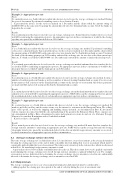Page 548 - SAIT Compendium 2016 Volume2
P. 548
IN 63 (2) Income Tax acT: InTeRPReTaTIon noTes IN 63 (2)
Example 2 – Appropriate spot rate
Facts:
X, a natural person, is a South African resident who has not elected to use the average exchange rate method. During the year of assessment X performed consulting services for a client in Canada.
X presented the invoice for the services rendered on 1 December and the client settled the amount owing of CAD100 000 on the same date by paying the amount directly into X’s Canadian bank account. X left the funds on deposit in the account.
Result:
X is a natural person who has not elected to use an average exchange rate. X must therefore translate the fee received in CAD to rand using the appropriate spot rate. An appropriate spot rate in these circumstances would be the closing spot buy rate quoted by an authorised dealer on 1 December.
Example 3 – Appropriate spot rate
Facts:
Y is a South African resident who has not elected to use the average exchange rate method. Y performed consulting services for a client in Canada. Y presented the invoice for the services rendered on 1 December and the client settled the amount owing of CAD100 000 on the same date via a wire transfer into Y’s South African bank account. Y noti ed the bank of the incoming payment on 28 November and xed the exchange rate for two days at the then current spot buy rate. Y’s bank received the CAD100 000 on 1 December and converted the amount to rand at the xed spot rate.
Result:
Y is a natural person who has not elected to use the average exchange rate method and must therefore translate the fee received in CAD to rand using an appropriate spot rate. An appropriate spot rate in these circumstances would be the xed spot buy rate to which Y and the bank agreed on 28 November.
Example 4 – Appropriate spot rate
Facts:
Z, a natural person, is a South African resident who has not elected to use the average exchange rate method. Z owns a number of rental properties in Canada as well as a number of interest-bearing Canadian bank accounts. Z receives rent from tenants as well as interest on the Canadian bank accounts on the last day of every month. All of these payments are made in CAD and are left on deposit by Z in the Canadian bank accounts.
Result:
Z is a natural person who has not elected to use the average exchange rate method and must therefore translate the rent and interest received in CAD to rand using the appropriate spot rate. SARS will accept the closing spot buy rate quoted by an authorised dealer on the last day of each month as an appropriate spot rate in these circumstances.
Example 5 – Appropriate spot rate
Facts:
K, a natural person, is a South African resident who has not elected to use the average exchange rate method. K markets and sells jewellery and decorative items over the internet to customers in the European Union. The selling price of K’s goods, as well as the shipping and handling charges incurred, are denominated in Euro. K also incurs various expenses in connection with the sale and marketing of the goods in the European Union. These expenses are also denominated in Euro. Euro- denominated receipts and payments are made in and out of a Customer Foreign Currency Account that K maintains with a South African bank.
K does not have a foreign PE.
Result:
K is a natural person who has not elected to use the average exchange rate method. K must therefore translate the foreign currency amounts to rand using an appropriate spot rate. SARS will accept the average buy and sell closing telegraphic transfer rate quoted by an authorised dealer for the days on which foreign currency amounts are received, accrued or incurred as an appropriate spot rate in thesecircumstances.
4.2 Average exchange rate [section 1(1)]
The term ‘average exchange rate’ is de ned in section 1(1), in relation to a year of assessment, as the average determined by using the closing spot rates at the end of daily or monthly intervals during that year of assessment which must be consistently applied within that year of assessment. The term is used extensively in the various rules, which are discussed in this Note, for translating foreign currency amounts to rand.
A person may choose between daily or monthly intervals each year. This choice must, however, be applied consistently in determining the average exchange rates for all foreign currency amounts recognised within that year. For example, a person may not use daily intervals to determine the average exchange rate for amounts received in euro and monthly intervals to determine the average exchange rate for amounts received in CAD.
4.2.1 Daily intervals
The average exchange rate for a year of assessment determined at daily intervals must be calculated by – • adding together the closing spot rates quoted at the end of each day during the year of assessment; and
540 saIT comPendIum oF Tax LegIsLaTIon VoLume 2


